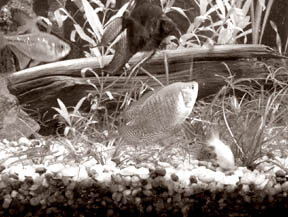|
dailynews |
|
|
|
|
|
OTHER LINKS |

|

|

|
From ocean to aquaria
NAQDA should indeed be commended for the programmes it has activated to assist the industry. The Ornamental Fish, Aquatic Plants & Accessories exhibition known as "Min Visithuru" is one example. This year the event will take place from 10 - 13 August. Last year NAQDA also organized an International Exhibition with the assistance rendered by the EDB. All these efforts should be appreciated. They are healthy signs for a good future. The ornamental fish sector is an extensive and global component of international trade. Global statistics report that the export value in 2005 of ornamental fish was over US$ 500 million. Such a vast and important industry has the potential to contribute to the sustainable development of aquatic resources in third world countries.
The industry has become a valuable foreign exchange earner during the past few years. An increase in exports has been observed following technological developments in the breeding and rearing of fish. Around 75 per cent of ornamental fish exported from Sri Lanka are marine varieties. The export of marine ornamental fish sometime back, however, was heavily dependent on the capture of wild stocks with over 200 marine species belonging to 40 families were being exported. However the increasing pressure on marine ornamental wild fish stocks has in the recent past led to the depletion of several wild fish populations; as a result government has prohibited or restricted certain marine and freshwater fish species from export. Presently, we contribute approximately 3% of the world's demand for ornamental fish. Of the freshwater fish species exported from Sri Lanka, the guppy ranks the highest, followed by swordtails, angels, platys and various species of tetras. According to statistical sources, there are over 70 large and small-scale ornamental fish exporters in Sri Lanka. An estimated 2,500 people are engaged in the production and breeding of which around 30 percent are estimated to be women, however, no thorough survey has been carried out to this effect. We are endowed with favourable climatic conditions that make it suitable for rearing and breeding freshwater fish. In addition to the great diversity of fauna, Sri Lanka is also blessed with its rich resources of aquatic plants which could be easily propagated for ornamental purposes. Some experts say we have more species of aquatic plants than in any other region in Asia. In spite of this advantage, we have not done extensive research to identify how many species are suitable for ornamental purposes. What are the urgent problems faced by the industry today? According to exporters, among the problems of the local industry are inadequate stocks of freshwater aquarium fish, lack of communication between small-scale breeders and established exporters, lack of research and development in freshwater aquarium fish breeding, lack of government support to the industry, and lack of adequate facilities for packaging and air transport. So it is quite obvious what we need today urgently is a professional in-depth study aiming to assess the present status and future trends in the ornamental fish industry in Sri Lanka; to overview the present fish production system which caters for the international market; and to identify present constraints within the industry. A comprehensive research will be instrumental in answering few important questions: What integrated management strategy will accommodate the requirements of the parties that influence, or are influenced by the trade in ornamental fish? Which management strategy will be the most profitable and, at the same time, least destructive to the environment and the fish therein? What are the political, social and economic constraints to the implementation of such a management strategy? What is the role of consumer demand in sustainable development? With concrete knowledge of fish diversity, abundance, distribution and habitats, and the socio-economic contexts of those involved in the trade, the research can propose a variety of solutions and their possible consequences regarding marketing strategies, legislative prudence and environmental preservation. Such a case study could eventually examine the impact, outreach, cost effectiveness, overall effectiveness and sustainability of the industry in the long-run. It can pinpoint lessons and make observations that can add to the current thinking about the envisaged development project by NAQDA. The ornamental fish industry can play an enormous role in fish conservation. This is something that has not yet been addressed in sufficient detail, and not been exploited to its full potential. It is time we start doing it. |
 Ornamental fish: The National Aqua Culture Development Authority (NAQDA)
recently spearheaded the launching of Ornamental Fish Development
project which aims to develop propagation and breeding of high value
ornamental fish and other indigenous species which are in demand in the
world market.
Ornamental fish: The National Aqua Culture Development Authority (NAQDA)
recently spearheaded the launching of Ornamental Fish Development
project which aims to develop propagation and breeding of high value
ornamental fish and other indigenous species which are in demand in the
world market.  This industry has a long history in Sri Lanka and was started with
household based small-scale outlets in cities. In the early 1930s, there
were several small-scale importers, breeders and hobbyists; the first
commercial type aquarium was started in 1952 in Colombo and it has now
developed into a thriving industry affording profits and employment for
many thousands.
This industry has a long history in Sri Lanka and was started with
household based small-scale outlets in cities. In the early 1930s, there
were several small-scale importers, breeders and hobbyists; the first
commercial type aquarium was started in 1952 in Colombo and it has now
developed into a thriving industry affording profits and employment for
many thousands. 







